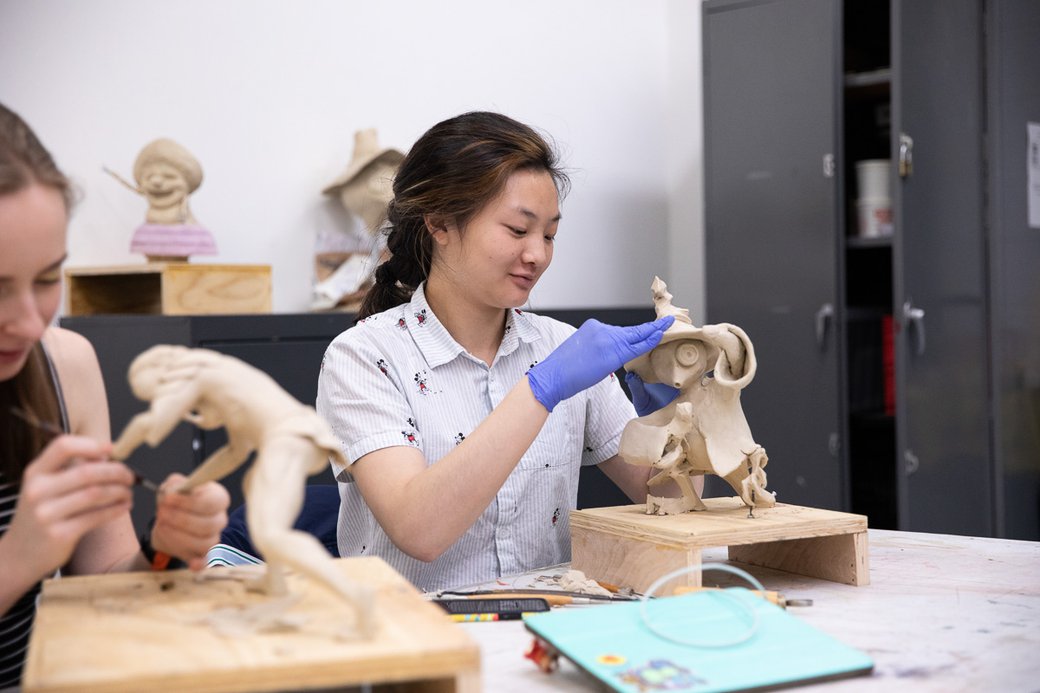You got into art college. Now what?
Your college acceptance letters are rolling in. Yay! Now, how to choose which college to attend?
You did it! The long wait is over. You submitted your college applications and got into the school of your dreams. Actually, you got into several schools... Uh oh. What’s next? How do you figure out which college to attend?
First of all, congrats on having a great problem to solve. The colleges likely sent you information on how to officially accept your offer of admission, and there’s probably a fast-approaching deadline listed for you. But first, you should take the time to examine all your options and figure out how they compare in price, experience, and potential. Here are four ways to start the process of picking between colleges and what to consider during each step.

Learn to use new equipment in a CCA first-year studio.
1: Talk to a counselor
At a one-on-one meeting with an admissions counselor, you can get help understanding the complete offer you’ve been sent in your admit# packet and ask about any costs you’ll have after financial aid. Even if you’ve talked to a counselor at that college before, chances are you have new questions that are more focused on the day-to-day experience. You may want to ask questions about deeper costs and benefits like student resources, work-study jobs, learning accommodations, health insurance, and technology you’ll need for your major and if the college offers supplies.
An admissions counselor can also answer specific questions you might have about the difference between two majors you’re considering. It’s worth asking why you should study your discipline at an art college—and why you should study it at that art school in particular. Write down a list of the questions you have and put them in a spreadsheet or table so you can track and compare answers for each college. Be sure to include a column for general notes too so you can refer to it later as you make your decision.
2: Take an in-person or virtual tour
You’ve probably taken a tour already, but do it again, this time looking for new aspects of the campus experience. How close is the residence hall you’ll live in to first-year classrooms and work spaces? What about food, laundry, transportation, art supplies, and entertainment? Where are the libraries, studios, and study spaces? Are there resource centers on campus where you can rent equipment or explore materials? Can you picture yourself here? Does it feel welcoming to you? If you can’t visit the campus in person, take a virtual tour. At CCA, we offer virtual and in-person tours with current students as your guide. This is a great opportunity to ask them about the pros and cons of actual student life.

Practice with interdisciplinary tools in CCA courses like Sculpture for Animation.
3: Learn more about the first-year program
First-year programs at art and design colleges vary by school. The colleges you were admitted to likely have pages on their websites dedicated to explaining what to expect during your first year and how the experience is structured to set you up for success in your major. It’s important to consider your goals before you take this step so you know what to look for. Do you want to dig right into making and studio work? Do you want to gain interdisciplinary experience beyond your major? Does the school have a robust lineup of programs and shops that will complement what you want to make? Does it have classes and career support that could help you long-term? Pick the top three things you’re looking for in a first-year experience and mark down which colleges offer them and which don’t.
4: Explore recent work by students
Each school has its own culture and is guided by certain values distinct to its location and wider community. For example, at CCA in the Bay Area, future-focused social justice and innovative sustainability practices deeply inform our curriculum. What do the schools you’re considering value? How long have they been around and worked toward these values?
A great way to see how these values are expressed in the classroom is by checking out current student projects and coursework. On the college’s website, look around for course descriptions and reading lists. Explore showcases of senior thesis projects. Look at their lineup of events on campus. Or, visit their social media accounts and hashtags to see what students are making and talking about.
Do the discussions inspire you? Does the student work spark your own ideas or make you excited to learn? Are these students and the faculty people you’d like to learn alongside? If so, you just might have your answer.
Take the first step in accepting your CCA admission